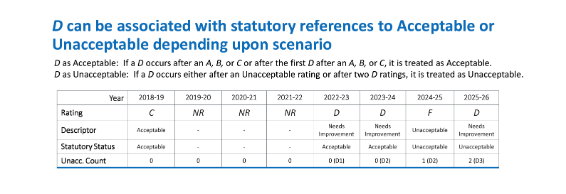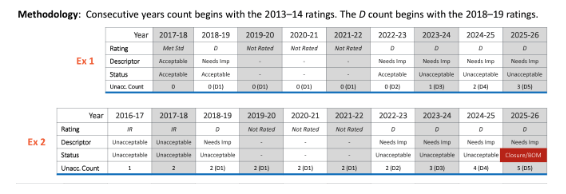How the changes affect Consecutive Years and D Ratings
The education system in Texas is constantly evolving to better serve its students. One change is the introduction of Senate Bill 1365, which includes a range of measures to improve accountability in schools. A key area of focus is the count of consecutive years of unacceptable performance and D ratings.
In this blog, we will delve into the details of SB 1365 and its impact on the education system.
SB 1365
SB 1365 includes various provisions related to school accountability. It permits the commissioner to assign a Not Rated designation to a district or campus under certain conditions, allows the commissioner to assign a Not Rated label if the number of students enrolled in the district or campus is insufficient to accurately evaluate the performance, and requires the number of consecutive years of unacceptable performance to be reported annually. However, when it comes to accountability reset, we need to focus on the count of consecutive years of unacceptable performance and D ratings.
Under SB 1365, the count of consecutive years of unacceptable performance begins with the 2014 accountability ratings. Unacceptable performance includes overall Improvement Required, F, and D ratings. An A, B, C, Met Standard, or Met Alternative Standard rating resets the consecutive count to 0 for that year. Unacceptable ratings received during the years of Not Rated do not increase the consecutive year count. However, an acceptable rating of A, B, or C earned during these years does break the consecutive year count.
D Ratings Impacts
D ratings have several impacts under SB 1365 including:
- The baseline year for starting the D count is 2019 ratings, and the first year a third overall D could impact the count of consecutive year counts is August 2024.
- An overall rating of D does not break the count of consecutive years of unacceptable performance, but a third overall D affects interventions and/or sanctions under TEC, §39A.118.
- This increase occurs only if a district, open-enrollment charter school, or campus has not broken the chain of consecutive years by earning an overall A, B, or C.
- An overall rating of D following an F or Improvement Required rating pauses the count of consecutive years until the third overall D.
TEA provides several examples of what this looks like in action.



TEA has updated the 3 F Rule to include Ds.
If a campus or district earns 3 out of 4 Fs in the domains of Student Achievement, School Progress, Part A: Academic Growth, School Progress, Part B: Relative Performance, or Closing the Gaps, the highest score they can earn is a 59 or an F. If a campus or district receives 3 out of 4 Ds in the domains, the highest overall score will be a 69 or a D.
If a scaled score less than 60 is received in three of the four areas of Student Achievement; School Progress, Part A: Academic Growth; School Progress, Part B: Relative Performance; or Closing the Gaps, the highest scaled score a district, open-enrollment charter school, or campus can receive for the overall rating is a 59.
In conclusion, SB 1365 has introduced several measures to improve accountability in schools. By understanding the impact of consecutive years and D ratings, schools can work towards improving their overall performance. This results in better outcomes for their students.
To get the latest information on A-F Accountability, subscribe to Accountability Weekly or visit our website at https://esc13.net/school-performance/a-f. Read more about the changes to the A-F system on the ESC Region 13 blog.
Melinda Marquez is the Director of Accountability, Assessment, and Leadership Systems here at ESC Region 13.






Add comment